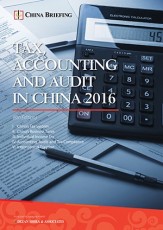Understanding China’s VAT Accounting Guidelines
By Dezan Shira & Associates
Editor: Tongyu Zhang
On December 3, 2016, China’s Ministry of Finance (MOF) issued regulations on accounting treatment of Value-added tax (VAT), which immediately came into force from the date of issuance. The latest regulations are presented as guidelines for companies to handle accounting adjustments in advance of the annual reporting deadline. The regulations modify the sub-items under the “tax payable” category, clarify the presentation method of these items in financial statements, and standardize the accounting handling methods for VAT-related businesses. Note that transactions concluded during the period from May 1, 2016 to the effective date of the regulations, whose assets and liabilities are affected, shall be adjusted according to the new regulations. The regulations will prevail if inconsistent with the national unified accounting system.
This article therefore gives a brief introduction of some important accounting treatment of VAT, as well as identifying some critical implications for foreign companies doing business in China.
Establishment of accounting items
According to the regulations, general taxpayers should add six sub-items under the term “tax payable”, while the sub-item “adjusted VAT after inspection” has been removed. After the adjustment, the amount of VAT-related sub-items under the item “tax payable” has been increased from five to 10, namely:
- VAT payable
- Unpaid VAT
- Prepaid VAT
- Input tax to be credited
- Input tax to be verified
- Output tax to be recognized
- VAT credit balance
- Simplified VAT calculation
- VAT payable for trading of financial products
- VAT withheld
- Also, “business tax and surcharge” in the income statement shall be adjusted to “tax and surcharge”.
VAT accounting handling regulation
For activities where input tax can be credited, such as purchasing goods, processing, repair and replacement services, other services, and intangible assets and immovable properties, the VAT creditable should be recorded as “VAT payable (input tax)”. Meanwhile, input tax that cannot be verified in the current month or is not allowed to be credited should be classified as “input tax to be verified”, and recorded in “VAT payable (input tax)” and “VAT payable (transfer out input tax)” respectively, after being verified by tax authorities. One noticeable change for the treatment of input tax is that if a general taxpayer has examined and accepted its purchased goods, but has neither received VAT fapiao nor made payment, it is not required to estimate and record the input VAT until receiving the invoice. However, for small-scale taxpayers carrying out activities such as purchasing, the VAT specified is to be recorded as relevant costs, expenses, or assets, not “VAT payable”.
Under the current VAT system, an overseas entity or individual who commits taxable activities in China without establishing any business office in China, their domestic buyers should be considered a VAT withholding agent, and the VAT incurred is to be recorded as the new item “VAT withheld”.
For sales activities, as well as activities deemed as sales according to tax laws, such as an enterprise that sells goods and services, output tax should be recorded as “VAT payable (output tax)” or “simplified VAT calculation”, depending on the calculation method. In the event of a purchase return, taxpayers should make a reversing entry based on the special red-letter VAT invoice. For income which has been recognized prior to the pilot scheme of replacing business tax by VAT, i.e. January 1, 2012, if business tax has been allotted but not paid or no business tax obligation arises, the enterprise should adjust accounts to recognize the VAT while writing off the income of the current period when its VAT tax obligation occurs.
![]() RELATED: Tax and Compliance Services from Dezan Shira & Associates
RELATED: Tax and Compliance Services from Dezan Shira & Associates
If an enterprise has to calculate VAT on a net basis, i.e. if its sales revenue is permitted to be credited as the relevant costs and expenses occur, it should record such transactions as costs and expenses and later adjust the creditable amount as “VAT payable (deductible output tax)” or “simplified VAT calculation” after receiving VAT fapiao.
In addition, the regulations clarify the accounting treatment for the trading of financial products, in which sales revenue recorded is based on the balance after offsetting losses against profits. At the end of the month when the ownership of financial products is actually transferred, the transaction will be recorded as “investment gain” and “VAT payable for trading of financial products”. In the event of losses from the transfer, the creditable balance can be carried forward to the next month. If there is a debit balance in “VAT payable for trading of financial products” at the end of the year, which implies an unrealized creditable amount, it will change to “investment gain”.
“Export rebates receivable” is used to record export tax refunds received by a taxpayer for export of goods, including VAT, exercise tax, and other taxes refunds. The end-of-period debit balance of this item reflects the tax refundable which has not been received. The accounting treatment of such activities may be different due to the application of “exemption, write-off, or refund” method. While a general taxpayer not entitled to use such method just estimates the export rebate and records it when the rebate is recognized, an entitled taxpayer should have several extra steps to meet the requirements accompanied with the procedure of “exemption, write-off, or refund” in order to enjoy a wider range of tax incentives. Foreign investors who participate in China’s manufacturing industry or foreign trade may adopt this kind of approach to optimize their tax structure.
Listing of VAT-related items in financial statements
In a balance sheet, the end-of-period debit balance of the following items, which imply that the balance remains to be credited, will be listed as either “other current assets” or “other noncurrent assets”:
- VAT payable
- Unpaid VAT
- Input tax to be credited
- Input tax to be verified
- VAT credit balance
End-of-period credit balance of “output tax to be recognized” will be listed under “other current liabilities” or “other noncurrent liabilities”, and credit balance of “unpaid VAT”, “simplified VAT calculation”, “VAT payable for trading of financial products”, and “VAT withheld” shall be listed under “tax payable”.
Key takeaways
The issuance of the regulations demonstrates the broader application of China’s reformed VAT system. Although aiming to reduce corporate tax burdens, such general level reform still requires market entities to adopt proper strategies to optimize their tax structures. Due to the extent of changes brought by the VAT reform, foreign companies and investors should pay extra attention to ensuring regulatory compliance and hone their tax planning in regard to their specific industries. For instance, foreign investors investing in the manufacturing and financial sectors should take different approaches to manage their taxes in accordance with the regulation. Thus, extra efforts are demanded in terms of financial personnel training and tax planning augmentation. Last but not least, as the regulation was published at the end of 2016, foreign companies doing business in China must factor in the time needed to adjust their accounting books and financial reports accordingly.
|
Asia Briefing Ltd. is a subsidiary of Dezan Shira & Associates. Dezan Shira is a specialist foreign direct investment practice, providing corporate establishment, business advisory, tax advisory and compliance, accounting, payroll, due diligence and financial review services to multinationals investing in China, Hong Kong, India, Vietnam, Singapore and the rest of ASEAN. For further information, please email china@dezshira.com or visit www.dezshira.com. Stay up to date with the latest business and investment trends in Asia by subscribing to our complimentary update service featuring news, commentary and regulatory insight.
|

 Annual Audit and Compliance in China 2016
Annual Audit and Compliance in China 2016
In this issue of China Briefing, we provide a comprehensive analysis of the various annual compliance procedures that foreign invested enterprises in China will have to follow, including wholly-foreign owned enterprises, joint ventures, foreign-invested commercial enterprises, and representative offices. We include a step-by-step guide to these procedures, list out the annual compliance timeline, detail the latest changes to China’s standards, and finally explain why China’s audit should be started as early as possible.
 Tax, Accounting, and Audit in China 2016
Tax, Accounting, and Audit in China 2016
This edition of Tax, Accounting, and Audit in China, updated for 2016, offers a comprehensive overview of the major taxes that foreign investors are likely to encounter when establishing or operating a business in China, as well as other tax-relevant obligations. This concise, detailed, yet pragmatic guide is ideal for CFOs, compliance officers and heads of accounting who must navigate the complex tax and accounting landscape in China in order to effectively manage and strategically plan their China-based operations.
 Establishing & Operating a Business in China 2016
Establishing & Operating a Business in China 2016
Establishing & Operating a Business in China 2016, produced in collaboration with the experts at Dezan Shira & Associates, explores the establishment procedures and related considerations of the Representative Office (RO), and two types of Limited Liability Companies: the Wholly Foreign-owned Enterprise (WFOE) and the Sino-foreign Joint Venture (JV). The guide also includes issues specific to Hong Kong and Singapore holding companies, and details how foreign investors can close a foreign-invested enterprise smoothly in China.
- Previous Article Vue d’Ensemble des Prix de Transfert en Chine
- Next Article China’s Wastewater Treatment Industry: Opportunities for Foreign Investors









